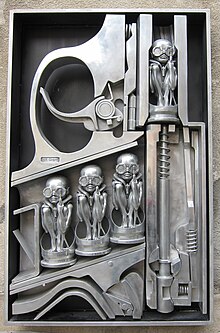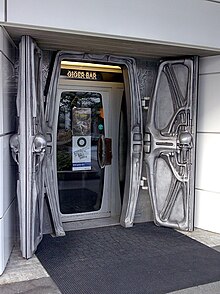H. R. Giger
- Birth Date:
- 05.02.1940
- Death date:
- 12.05.2014
- Person's maiden name:
- Hans Rudolf "Ruedi" Giger
- Extra names:
- Ганс Рудольф Гигер, Ганс Руди Гигер, Hans Rüdi Giger, Hans Rudolf Giger
- Categories:
- Artist, Designer, Painter
- Nationality:
- swiss
- Cemetery:
- Set cemetery
Hans Rudolf "Ruedi" Giger (/ˈɡiːɡər/; born 5 February 1940; died 12 May 2014) was a Swiss surrealist painter, sculptor, and set designer. He was part of the special effects team that won an Academy Award for Best Achievement for Visual Effects for their design work on the film Alien. He was named to the Science Fiction and Fantasy Hall of Fame in 2013
Life and career
Giger was born in 1940 in Chur, capital city of Graubünden, the largest and easternmost Swiss canton. His father, a chemist, viewed art as a "breadless profession" and strongly encouraged him to enter pharmaceutics, Giger recalls. Yet he moved in 1962 to Zürich, where he studied Architecture andindustrial design at the School of Applied Arts until 1970. Giger had a relationship with Swiss actress Li Tobler until she committed suicide in 1975. He married Mia Bonzanigo in 1979; they separated a year and a half later.
Giger's style and thematic execution have been influential. His design for theAlien was inspired by his painting Necronom IV and earned him an Oscar in 1980. His books of paintings, particularly Necronomicon and Necronomicon II (1985) and the frequent appearance of his art in Omni magazine continued his rise to international prominence. Giger is also well known for artwork on several music recording albums.
In 1998 Giger acquired the Château St. Germain in Gruyères, Switzerland, and it now houses the H. R. Giger Museum, a permanent repository of his work. The artist lived and worked in Zurich with his wife, Carmen Maria Scheifele Giger, who is the Director of the H.R. Giger Museum.
On 12 May 2014, Giger died in a hospital after having suffered dangerous injuries when he tripped and fell down some stairs.
Style

Giger got his start with small ink drawings before progressing to oil paintings. For most of his career, Giger has worked predominantly in airbrush, creating monochromatic canvasses depicting surreal, nightmarish dreamscapes. However, he has now largely abandoned large airbrush works in favor of works with pastels, markers or ink.
His most distinctive stylistic innovation is that of a representation of human bodies and machines in a cold, interconnected relationship, he described as "biomechanical". His paintings often display fetishistic sexual imagery. His main influences were painters Ernst Fuchs and Salvador Dalí. He met Salvador Dalí, to whom he was introduced by painter Robert Venosa. He was also a personal friend of Timothy Leary. Giger suffers from night terrors and his paintings are all to some extent inspired by his experiences with that particular sleep disorder. He studied interior and industrial design at the School of Commercial Art in Zurich (from 1962 to 1965) and made his first paintings as a means of art therapy.
In 2007, Giger and his work were subjects of a 19-minute documentary, H.R. Giger's Sanctuary, which toured internationally and was released on DVD in May 2008.
Influences
There is evidence that Giger was very influenced by the works of the American horror fiction writer H.P. Lovecraft, such as in his first compendium of images Necronomicon, which is a clear reference to Lovecraft's Necronomicon.
Other works


In the 1960s and 1970s, Giger directed a number of films, including Swiss Made(1968), Tagtraum (1973), Giger's Necronomicon (1975) and Giger's Alien(1979).
Giger has created furniture designs, particularly the Harkonnen Capo Chair for a movie of the novel Dune that was to be directed by Alejandro Jodorowsky. Many years later, David Lynch directed the film, using only rough concepts by Giger. Giger had wished to work with Lynch, as he states in one of his books that Lynch's film Eraserhead was closer than even Giger's own films to realizing his vision.
Giger has applied his biomechanical style to interior design. One "Giger Bar" sprang up in Tokyo, but the realization of his designs were a great disappointment to the artist, since the Japanese organization behind the venture did not wait for his final designs, but decided to move ahead with nothing more than Giger's rough preliminary sketches. For that reason, Giger disowned the Tokyo Giger Bar and never set foot inside. Within a few years, the establishment was out of business. The two Giger Bars in his native Switzerland (in Gruyères and Chur), however, were built under Giger's close personal supervision and reflect his original concepts for them accurately. At The Limelight in Manhattan, Giger's artwork was licensed to decorate the VIP room, the uppermost chapel of the landmarked church, but it was never intended to be a permanent installation and bore no similarity to the real Giger Bars in Switzerland. The arrangement was terminated after two years when the Limelight closed its doors. As of 2009 only the two authentic Swiss Giger Bars remain.
His art has greatly influenced tattooists and fetishists worldwide. Under a licensing deal Ibanez guitars released an H. R. Giger signature series: the Ibanez ICHRG2, an Ibanez Iceman, features "NY City VI", the Ibanez RGTHRG1 has "NY City XI" printed on it, the S Series SHRG1Z has a metal-coated engraving of "Biomechanical Matrix" on it, and a 4-string SRX bass, SRXHRG1, has "N.Y. City X" on it.
Giger is often referred to in pop culture, especially in science fiction and cyberpunk. William Gibson (who wrote an early script for Alien 3) seems particularly fascinated: a minor character in Virtual Light, Lowell, is described as having New York XXIV tattooed across his back, and in Idoru a secondary character, Yamazaki, describes the buildings of nanotech Japan as Giger-esque.
Movies- Dune (designs for unproduced Alejandro Jodorowsky adaptation of the Frank Herbert novel; the movie Dune was later made in an adaptation by David Lynch.)
- Alien (designed, among other things, the Alien itself, "The Derelict" and the "Space Jockey")
- Aliens
- Alien 3 (designed the dog-like Alien bodyshape, plus a number of unused concepts, many mentioned on the special features disc of Alien 3)
- Alien Resurrection
- Poltergeist II: The Other Side
- Killer Condom
- Species (designed Sil and the Ghost train in a dream sequence)
- Batman Forever (designed radically different envisioning of the Batmobile; design not used in the film)
- Future-Kill (designed artwork for the movie poster)
- Tokyo: The Last Megalopolis (creature designs)
- Prometheus (the film includes "The Derelict" spacecraft and the "Space Jockey" designs from the first Alien film, as well as original extraterrestrial murals created exclusively for the new movie. Unlike Alien Resurrection the film credited H. R. Giger with the original designs.)

- Celtic Frost: To Mega Therion
- Magma: Attahk
- Emerson, Lake & Palmer: Brain Salad Surgery (1973)
- Steve Stevens' Atomic Playboys
- Mylène Farmer: Mylenium Tour (1999, sculpture of Isis on stage)
- Deborah Harry, portraits for Koo Koo album cover and videos "Backfired" and "Now I Know You Know" (1981)
- Clepsydra: Hologram (1991, holographed sculpture for the cover)
- hide: Hide Your Face
- Carcass: Heartwork
- Danzig: Danzig III: How the Gods Kill
- Dead Kennedys' album Frankenchrist, Poster insert of Landscape XX (which led to an obscenity trial)
- Atrocity – Hallucinations
- Black Sun Productions
- Island: Pictures
- SHINE[disambiguation needed] – Inthecentre (1996, tonal compositions of H. R. Giger pictures by Schahram Poursoudmand / Lichtschrei)
- Korn's Jonathan Davis commissioned Giger to design and sculpt a microphone stand, with the requirement that it be biomechanical, erotic, and movable. The contract allowed for five aluminium microphone stands to be made, but Davis purchased only two of the three he was entitled to. The design of the microphone stand was later adapted to Giger's "Nubian Queen" transforming it into a fine art sculpture.
- Designed the stage for Mylène Farmer's 1999 "Mylenium" tour.
- Blondie's Chris Stein commissioned Lieber Guitars to create Stein's unique "Gigerstein" guitar based roughly on Giger's artwork, but without Giger's direct involvement.
- Helped to design the first professional video clip of "Böhse Onkelz" called "Dunkler Ort" (dark location) from their album "Ein böses Märchen ... aus tausend finsteren Nächten", which was released in 2000.
- Ibanez Guitars has released second generation of H. R. Giger Signature Models hr giger RG & hr giger S series with legacy artwork on the guitar body, second generation of 4-string guitar bass SRXHRG1 also released with the same concept.
- Triptykon: Eparistera Daimones
- Triptykon: Melana Chasmata
- Giger Bars in Switzerland's Chur and Gruyères
- Maison d'Ailleurs (House of Elsewhere) in Yverdon-Les-Bains
- Museum H. R. Giger in Gruyères
- Dark Seed and its sequel, Dark Seed II, both adventure games for the Amiga, Amiga CD32, Macintosh and the PC, were published by Cyberdreams. The games were also released for the PlayStation and Saturn in Japan.
Source: wikipedia.org, delfi.lv
No places

| Relation name | Relation type | Description | ||
|---|---|---|---|---|
| 1 |  | Stephanie Adams | Familiar |
No events set



